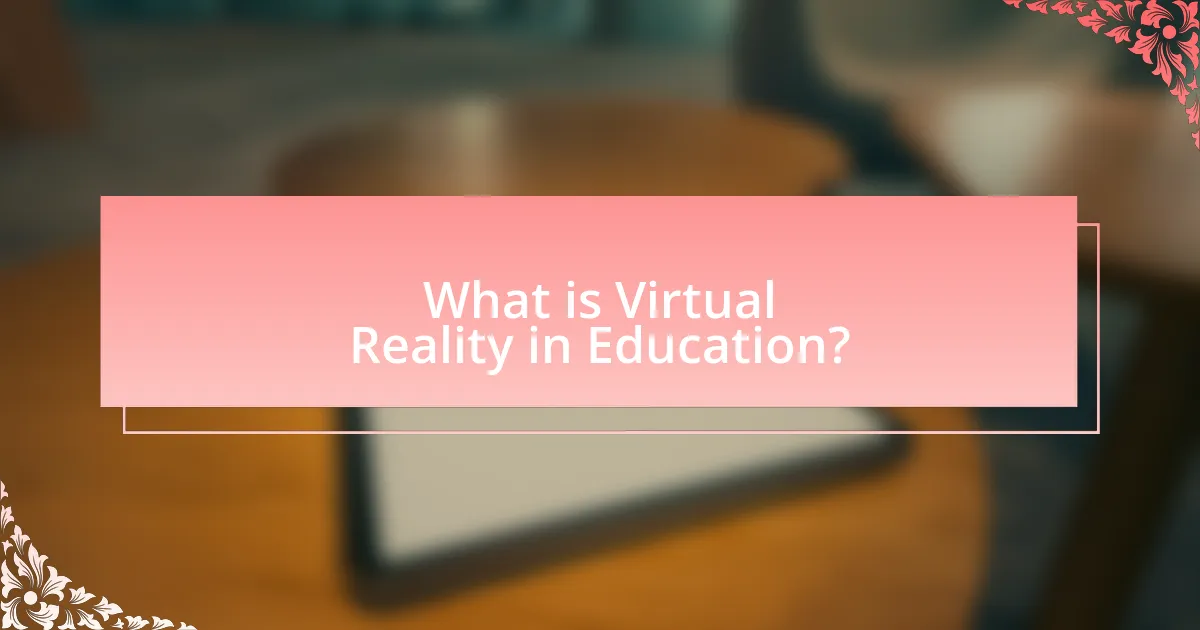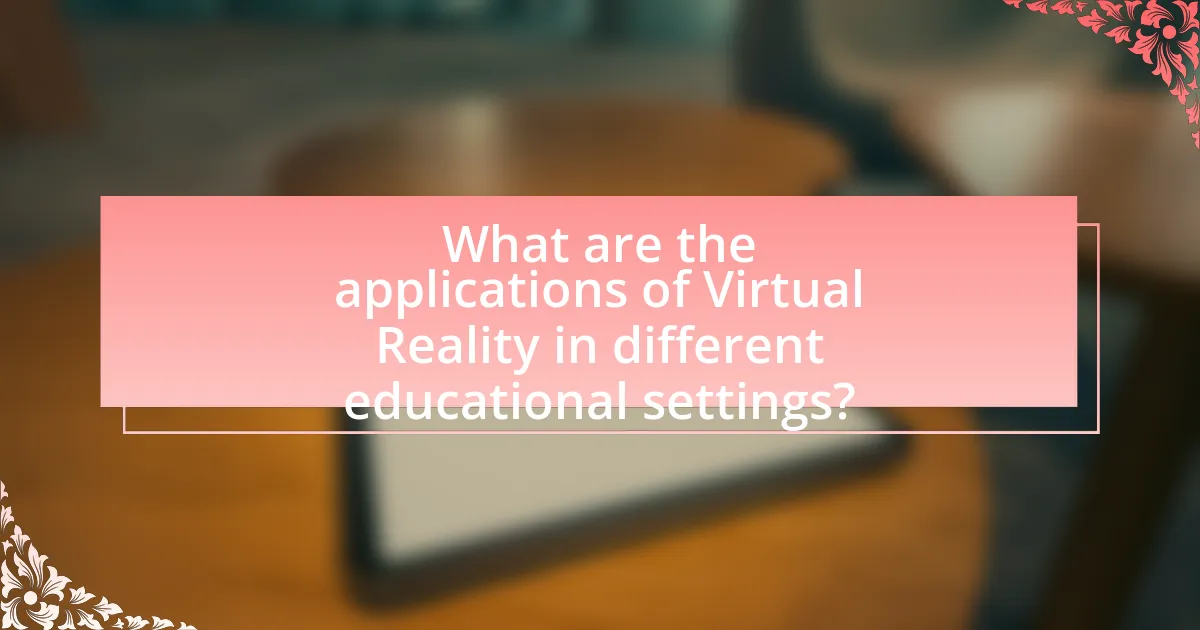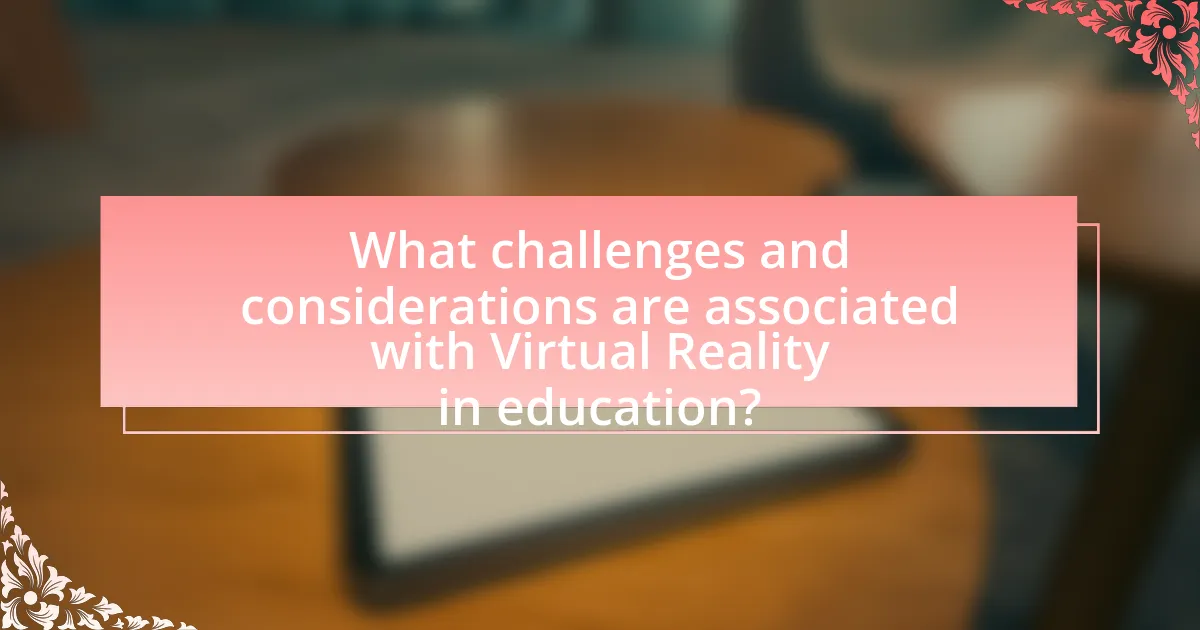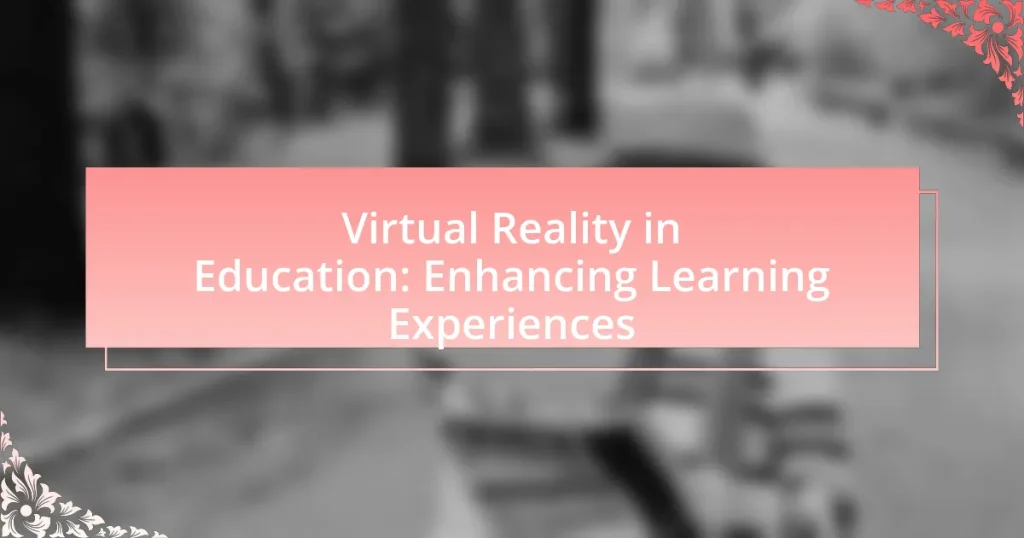Virtual Reality (VR) in education is an immersive technology that enhances learning experiences by creating simulated environments for students. This article explores how VR improves engagement, retention, and understanding of complex subjects through interactive simulations and immersive scenarios. Key technologies involved include head-mounted displays, motion tracking systems, and haptic feedback devices, which collectively facilitate experiential learning across various educational settings, from K-12 to higher education. The article also addresses the benefits, applications, challenges, and future trends of VR in education, providing insights into its transformative potential in enhancing teaching and learning outcomes.

What is Virtual Reality in Education?
Virtual Reality in education is an immersive technology that creates a simulated environment for learners, allowing them to engage with educational content in a highly interactive manner. This technology enhances learning experiences by providing realistic scenarios that facilitate experiential learning, such as virtual field trips or simulations of complex processes. Research indicates that students using virtual reality can improve retention rates and understanding of difficult concepts, as evidenced by a study published in the Journal of Educational Technology & Society, which found that VR can increase engagement and motivation among learners.
How does Virtual Reality enhance learning experiences?
Virtual Reality enhances learning experiences by providing immersive, interactive environments that facilitate deeper engagement and understanding of complex subjects. This technology allows learners to visualize and manipulate 3D models, participate in simulations, and experience scenarios that would be impossible or impractical in the real world. For instance, a study by the University of Maryland found that students using VR for learning retained information better and were more motivated compared to traditional learning methods. Additionally, VR can cater to various learning styles, making education more accessible and effective for diverse learners.
What technologies are involved in Virtual Reality for education?
Virtual Reality in education involves several key technologies, including head-mounted displays (HMDs), motion tracking systems, haptic feedback devices, and immersive software applications. Head-mounted displays, such as the Oculus Rift and HTC Vive, provide visual immersion by displaying 3D environments. Motion tracking systems, like the Microsoft Kinect, enable real-time interaction by tracking user movements. Haptic feedback devices, such as gloves or vests, enhance the experience by providing tactile sensations. Immersive software applications are designed to create educational content that leverages these technologies, facilitating interactive learning experiences. These technologies collectively enhance engagement and understanding in educational settings.
How do these technologies interact with educational content?
Virtual reality technologies interact with educational content by providing immersive and interactive experiences that enhance learning engagement and retention. These technologies allow students to explore complex concepts in a simulated environment, making abstract ideas more tangible. For instance, a study by Mikropoulos and Natsis (2011) found that students using virtual reality for science education demonstrated improved understanding and retention of material compared to traditional methods. This interaction facilitates experiential learning, where learners can practice skills in a safe, controlled setting, thereby reinforcing knowledge through active participation.
What are the key benefits of using Virtual Reality in education?
The key benefits of using Virtual Reality in education include enhanced engagement, improved retention of information, and the ability to simulate real-world experiences. Enhanced engagement occurs as students interact with immersive environments, which can lead to increased motivation and interest in the subject matter. Improved retention is supported by studies indicating that learners who use VR technology can recall information better than those who learn through traditional methods. For instance, a study published in the Journal of Educational Psychology found that students using VR scored 30% higher on retention tests compared to their peers. Additionally, VR allows for the simulation of complex scenarios, enabling students to practice skills in a safe environment, which is particularly beneficial in fields such as medicine and engineering.
How does Virtual Reality improve student engagement?
Virtual Reality (VR) improves student engagement by providing immersive and interactive learning experiences that capture students’ attention and enhance their understanding of complex subjects. Research indicates that VR can increase motivation and interest in learning; for instance, a study published in the Journal of Educational Technology & Society found that students using VR for science lessons showed a 30% increase in engagement compared to traditional methods. This heightened engagement is attributed to VR’s ability to simulate real-world scenarios, allowing students to explore and interact with content in a way that traditional classrooms cannot replicate.
What impact does Virtual Reality have on knowledge retention?
Virtual Reality significantly enhances knowledge retention by providing immersive and interactive learning experiences. Studies indicate that learners who engage with content through Virtual Reality retain information better than those using traditional methods. For instance, research published in the journal “Computers & Education” by Mikropoulos and Natsis (2011) found that students using Virtual Reality for learning exhibited a 30% improvement in retention rates compared to conventional instructional techniques. This effectiveness is attributed to the engaging nature of Virtual Reality, which stimulates multiple senses and encourages active participation, leading to deeper cognitive processing and long-term memory formation.

What are the applications of Virtual Reality in different educational settings?
Virtual Reality (VR) is applied in various educational settings to enhance learning experiences through immersive simulations, interactive environments, and experiential learning. In K-12 education, VR is used for virtual field trips, allowing students to explore historical sites or natural wonders without leaving the classroom. In higher education, VR facilitates complex training scenarios, such as medical simulations for nursing students, where they can practice procedures in a risk-free environment. Additionally, VR is utilized in vocational training, providing hands-on experience in fields like construction or aviation, where students can engage in realistic tasks. Research indicates that VR can improve retention rates and engagement, with studies showing that students using VR scored 20% higher on assessments compared to traditional learning methods.
How is Virtual Reality used in K-12 education?
Virtual Reality (VR) is used in K-12 education to create immersive learning experiences that enhance student engagement and understanding of complex subjects. By simulating real-world environments, VR allows students to explore historical sites, conduct virtual science experiments, and practice skills in a safe, controlled setting. Research indicates that students using VR in classrooms show improved retention rates and higher motivation levels, as evidenced by a study published in the Journal of Educational Technology & Society, which found that 80% of students reported increased interest in learning when using VR tools.
What specific subjects benefit from Virtual Reality in K-12?
Specific subjects that benefit from Virtual Reality in K-12 include science, history, mathematics, and language arts. In science classes, VR allows students to explore complex concepts like the human body or ecosystems in immersive environments. History lessons become more engaging as students can virtually visit historical sites or experience significant events. Mathematics education is enhanced through interactive simulations that visualize abstract concepts, making them more tangible. Language arts can utilize VR to create immersive storytelling experiences, improving comprehension and engagement. These applications are supported by research indicating that VR can increase student motivation and retention of information.
How do teachers integrate Virtual Reality into their curriculum?
Teachers integrate Virtual Reality (VR) into their curriculum by utilizing immersive simulations that enhance student engagement and understanding of complex concepts. For instance, in science classes, teachers may use VR to allow students to explore the human body or outer space, providing a hands-on experience that traditional methods cannot offer. Research indicates that VR can improve retention rates and foster deeper learning; a study by Mikropoulos and Natsis (2011) found that students using VR in educational settings demonstrated significantly better performance in spatial understanding compared to those who did not. This integration of VR not only supports diverse learning styles but also prepares students for a technology-driven future.
What role does Virtual Reality play in higher education?
Virtual Reality (VR) plays a transformative role in higher education by providing immersive learning experiences that enhance student engagement and understanding. VR allows students to explore complex concepts and environments in a simulated setting, which can lead to improved retention of information. For instance, a study published in the Journal of Educational Technology & Society found that students using VR for anatomy lessons scored 30% higher on assessments compared to traditional learning methods. This evidence supports the effectiveness of VR in facilitating experiential learning, making abstract concepts more tangible and accessible for students.
Which fields of study utilize Virtual Reality most effectively?
Virtual Reality is most effectively utilized in fields such as education, healthcare, architecture, and engineering. In education, VR enhances learning experiences by providing immersive simulations that improve engagement and retention. For instance, studies have shown that medical students using VR for surgical training demonstrate higher skill acquisition compared to traditional methods. In healthcare, VR is employed for pain management and rehabilitation, with research indicating that patients experience reduced pain levels during VR therapy sessions. Architecture and engineering benefit from VR by allowing professionals to visualize and interact with 3D models, facilitating better design decisions and client presentations. These applications underscore the transformative impact of Virtual Reality across various disciplines.
How do universities implement Virtual Reality in their programs?
Universities implement Virtual Reality (VR) in their programs by integrating immersive simulations into various curricula to enhance experiential learning. For instance, medical schools utilize VR for surgical training, allowing students to practice procedures in a risk-free environment, which has been shown to improve skill acquisition and retention. Additionally, universities employ VR for virtual field trips in geography and history courses, enabling students to explore locations and historical events interactively. Research indicates that such applications of VR can lead to increased engagement and improved learning outcomes, as evidenced by a study published in the Journal of Educational Technology & Society, which found that students using VR reported higher satisfaction and better understanding of complex concepts compared to traditional learning methods.

What challenges and considerations are associated with Virtual Reality in education?
Virtual Reality (VR) in education faces several challenges and considerations, including high costs, technological limitations, and the need for teacher training. The implementation of VR technology often requires significant financial investment for hardware and software, which can be a barrier for many educational institutions. Additionally, the technology may not be accessible to all students due to equipment availability or compatibility issues. Furthermore, educators must receive adequate training to effectively integrate VR into their teaching practices, as a lack of familiarity can hinder its potential benefits. Studies indicate that without proper support and resources, the effectiveness of VR in enhancing learning experiences may be compromised.
What are the potential drawbacks of using Virtual Reality in classrooms?
The potential drawbacks of using Virtual Reality in classrooms include high costs, technical issues, and the risk of motion sickness among students. High costs arise from the need for expensive hardware and software, which can strain educational budgets. Technical issues, such as software glitches or hardware malfunctions, can disrupt learning experiences and frustrate both teachers and students. Additionally, some students may experience motion sickness or discomfort while using VR, which can hinder their ability to engage with the material effectively. These drawbacks highlight the challenges educators face when integrating VR technology into the classroom.
How can educators address issues of accessibility in Virtual Reality?
Educators can address issues of accessibility in Virtual Reality by implementing adaptive technologies and inclusive design principles. By utilizing VR platforms that support various input methods, such as voice commands and eye-tracking, educators can ensure that students with different abilities can engage with the content. Research indicates that 15% of the global population experiences some form of disability, highlighting the need for accessible educational tools. Furthermore, incorporating feedback from users with disabilities during the development phase can lead to more effective and user-friendly VR experiences.
What are the costs associated with implementing Virtual Reality in education?
The costs associated with implementing Virtual Reality in education include hardware expenses, software licensing fees, content development costs, and training for educators. Hardware costs can range from $300 to $1,000 per VR headset, depending on the quality and specifications. Software licensing fees for educational VR applications can vary widely, often costing between $10 to $100 per user annually. Additionally, developing custom VR content can be expensive, with costs ranging from $5,000 to over $100,000 depending on complexity and interactivity. Training educators to effectively use VR technology may also incur costs, typically ranging from $500 to $2,000 per training session. These figures illustrate the financial investment required for successful VR integration in educational settings.
How can educators effectively implement Virtual Reality in their teaching?
Educators can effectively implement Virtual Reality (VR) in their teaching by integrating immersive experiences that align with curriculum objectives. This can be achieved through the use of VR applications that simulate real-world scenarios, allowing students to engage in experiential learning. For instance, a study by Mikropoulos and Natsis (2011) found that VR environments significantly enhance student motivation and understanding in subjects like science and history. By utilizing VR headsets and software tailored to educational content, teachers can create interactive lessons that foster deeper comprehension and retention of material. Additionally, incorporating collaborative VR experiences encourages teamwork and communication skills among students, further enriching the learning process.
What best practices should be followed when using Virtual Reality in lessons?
Best practices for using Virtual Reality in lessons include ensuring clear learning objectives, providing adequate training for both educators and students, and integrating VR experiences with traditional teaching methods. Clear learning objectives help focus the VR experience on specific educational outcomes, while training ensures that users can effectively navigate the technology. Integrating VR with traditional methods enhances retention and understanding, as supported by research from the University of Maryland, which found that students using VR scored higher on assessments compared to those using conventional methods. Additionally, it is crucial to consider accessibility and inclusivity, ensuring that all students can participate in VR activities.
How can teachers assess the effectiveness of Virtual Reality in learning?
Teachers can assess the effectiveness of Virtual Reality (VR) in learning by measuring student engagement, knowledge retention, and skill application. Engagement can be evaluated through observation and surveys that gauge student interest and participation during VR activities. Knowledge retention can be assessed using pre- and post-tests that compare students’ understanding of the subject matter before and after VR experiences. Skill application can be observed through practical assessments where students demonstrate their ability to apply what they learned in VR to real-world scenarios. Research indicates that VR can enhance learning outcomes; for instance, a study by Mikropoulos and Natsis (2011) found that students using VR showed significantly higher retention rates compared to traditional learning methods.
What future trends can we expect in Virtual Reality for education?
Future trends in Virtual Reality for education include increased accessibility through affordable VR devices, enhanced interactivity with AI-driven personalized learning experiences, and the integration of collaborative virtual environments for remote learning. As technology advances, VR platforms are expected to become more user-friendly and widely adopted in classrooms, allowing for immersive simulations that cater to diverse learning styles. Research indicates that immersive learning can improve retention rates by up to 75%, demonstrating the effectiveness of VR in educational settings. Additionally, the rise of cloud-based VR solutions will facilitate real-time updates and content sharing, further enriching the educational experience.
How might advancements in technology shape the future of Virtual Reality in education?
Advancements in technology will significantly enhance the future of Virtual Reality (VR) in education by enabling more immersive and interactive learning experiences. For instance, the integration of artificial intelligence can personalize VR content to cater to individual learning styles, improving engagement and retention. Additionally, improvements in hardware, such as lighter and more affordable VR headsets, will increase accessibility for students, allowing broader adoption in classrooms. Research indicates that immersive environments can lead to a 75% increase in information retention compared to traditional methods, demonstrating the effectiveness of VR in educational settings. Furthermore, advancements in cloud computing will facilitate real-time collaboration among students and educators in virtual spaces, enhancing teamwork and communication skills.
What innovations are on the horizon for Virtual Reality learning experiences?
Innovations on the horizon for Virtual Reality learning experiences include advancements in haptic feedback technology, which will allow users to feel physical sensations in virtual environments, enhancing immersion. Additionally, the integration of artificial intelligence will enable personalized learning experiences by adapting content to individual student needs in real-time. Research indicates that these innovations can significantly improve engagement and retention rates; for instance, a study by the University of Maryland found that VR can increase learning retention by up to 75% compared to traditional methods. Furthermore, the development of multi-user VR environments will facilitate collaborative learning, allowing students to interact and learn together in shared virtual spaces, thereby fostering teamwork and communication skills.
What practical tips can educators use to enhance learning with Virtual Reality?
Educators can enhance learning with Virtual Reality (VR) by integrating immersive experiences that align with curriculum objectives. For instance, using VR simulations allows students to explore complex concepts, such as the human anatomy or historical events, in a three-dimensional space, which can improve retention and understanding. Research indicates that students who engage with VR content demonstrate a 76% increase in knowledge retention compared to traditional learning methods. Additionally, incorporating collaborative VR experiences fosters teamwork and communication skills, as students can interact in a shared virtual environment. By providing structured guidance and clear learning outcomes, educators can maximize the effectiveness of VR in their teaching practices.


